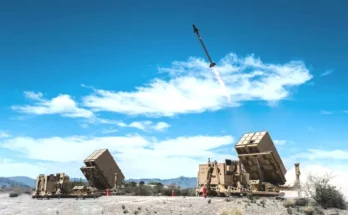Forecast International analyst Dan Darling and Defense One editor Marcus Weisgerber discuss the state of the global defense industry. Video – Defense One
“Follow the money” is a famous quote from All the President’s Men — and also the key to navigating the global defense market. At the 2023 Paris Air Show, Forecast International analyst Dan Darling and Defense One editor Marcus Weisgerber broke down global defense market spending trends from 2022 and explained what you can expect for the rest of 2023. Here are the highlights.
What trends are shaping the European market right now?
- The European market is experiencing an upswing due to the 2014 Russian annexation of Crimea. This resulted in the 2014 NATO Summit, where each member agreed to a 2% GDP standard for defense budgeting. This process was slow at first but the invasion of Ukraine catalyzed the process and saw members investing heavily in air defense systems, launch systems, recruitment, logistics, military transport and artillery systems.
- Supplies given to the Ukrainian cause have started a backfill for supplying countries as the need for their own weapon and supply stores becomes more evident.
- Sweden and Finland have now applied for NATO, which boxes Russia in by surrounding them with NATO countries. Future Combat Air Systems (FCAS) and the Government Contracting Assistance Program (GCAP) are high-priority, majorly funded programs.
- Before the Russo-Ukrainian War, the European defense environment was declining. At the end of the Cold War, Europe accounted for 30-35% of global defense spending whereas in 2014, they accounted for roughly 25% of the global distribution system.
- France recently announced a $413 billion European funding package through 2030.
- Germany recently announced a $100 billion European fund designed to re-equip the Bundeswehr. Money from this funding will go toward:
- FCAS
- F-35 Purchase
- P-8 Maritime Patrol Aircraft
- Ground Based Air Defense Systems
- Warships (F-125 Frigate)
- Chinook Helicopters (from the U.S)
What do European resupply efforts look like?
- Europe and U.S. ammunition stockpiles are running low due to the high expenditure rate in the Russo-Ukrainian War.
- The demilitarization much of Europe went through after the fall of the Soviet Union has exacerbated this problem, as many countries have been cutting personnel and equipment gradually over the last three decades.
- Europe has €500 million ammunition fund set aside for this effort.
- Much of the newly introduced funds will address the infrastructure involved in producing, transporting, and supplying frontline troops (e.g., production facilities, logistics, and resupply vehicles/mobility).
- Contracts take time to come to fruition. If you sign a contract today, it could be 2025 before you ever receive the equipment. The recent and overwhelming increase needed in production was not anticipated by the market.
- More trained personnel will be needed to maintain equipment as more systems, equipment and munitions are ordered. A lack of personnel led directly to more unmanned and autonomous systems.
What trends are forming with air defense systems in Europe?
-
- Poland is the main country for air defense systems as they have multiple programs with different capabilities (e.g., Shield of Poland).
- Poland looks to acquire a foreign-produced/-designed system and then work with the local industry to actually produce the system.
- Turkey’s S400 program does not appear to be going anywhere.
- MBDA Missile Systems is the prime supplier in Western Europe of Aster 3 Missiles and SAMP/T Systems (also known as Mamba).
- The air defense systems trend will shift to Finland/Norway/Sweden/Scandinavia, as they are in close proximity to Russia’s northern border.
- Finland is interested in switching priorities from artillery to more layered air defense missile systems.
What is China’s budget and trajectory?
- China’s military budget has been increasing for 30 years, producing frigates, destroyers, and aircraft carriers at a rate unparalleled since that of the U.S. during World War 2. They primarily focus on producing these systems:
- Helicopters
- UAVs
- Combat Aircraft
- Strategic Bombers
- Mil Transport/ Aerial Refueling
- Shipbuilding
- China is attempting to control their portions of the oceans, contrary to the U.S. Navy, which acts as an international police force with their global presence.
- Much of China’s research and development (R&D) is off the books, so much so that their budget is rather opaque. They do spend much of their R&D allotment on advanced technologies (e.g., AI, cyber, and quantum technology).
What is Japan doing to increase their capabilities?
- Japan is doubling their defense budget in a five-year span. They used to adhere to a 1% GDP cap for defense spending, but this was an informal agreement as defense spending was a very political topic in the Japanese government.
- Japan has realized that the threat of China requires far more than 1% of their GDP. They saw a 26% increase this year, and Forecast International forecasts a 14% increase next year.
- Japan plans to reach a 2% GDP cap for defense spending by 2027, which would require over $75 billion in additional spending. This rapid increase is not just due to the threat of China but also because of the lesson learned in Ukraine that industrial scale, near-peer warfare has not gone away.
- Japan acquired the Tomahawk missile as a counter strike weapon to respond to aggression from North Korea and China. Japan will eventually replace the Tomahawk with its own type-12 missile that they are currently expanding their range for.
- Japan is increasing their destroyer fleet size from six to eight, with two new Aegis-equipped destroyers. These function as their ballistic missile defense capability.
- GCAP partnered with the U.K. and Italy to develop a sixth-generation fighter. They are crossing the Tempest and FX programs to replace the aging Japanese F-15 fleet.
What is Australia doing to increase their capabilities?
- Australia has maintained a 2% of GDP for defense spending since 2019. The focus of the budget has been on unmanned vehicles/systems and the AUKUS submarine program.
- The AUKUS deal is set for 2040. Australia is experiencing hurdles in terms of nuclear technology sharing with the U.S.
- The aging Collins class submarines will need their lives extended and eventually retired far before 2040. The U.S. will need to fill this interim gap by providing Virginia-class submarines.
What major factors could alter global defense spending?
- Peace in Ukraine
Any armistice or end to the Russo-Ukrainian War would lead to a major shift in defense spending. European countries would lead this change as they have typically looked for an “off ramp” to defense spending when opportunities arise. - Another War
Any aggression by China would see amplified defense spending across the world, especially in Asia. Asian defense spending already accounts for 26% of global defense spending. - Economic Crisis
COVID relief packages coupled with increased defense spending are weighing heavily on budget deficits and debt. Any further economic downturns could stall defense spending across the world.
Find more free aerospace industry resources and forecasting data at FIAerospaceHub.com




